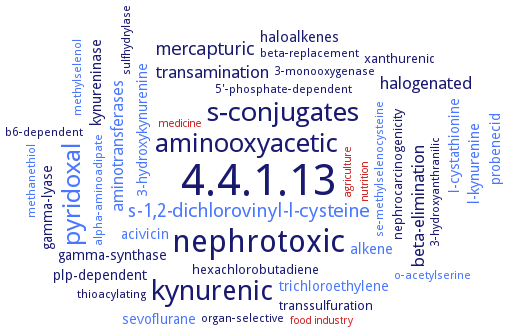4.4.1.13: cysteine-S-conjugate beta-lyase
This is an abbreviated version!
For detailed information about cysteine-S-conjugate beta-lyase, go to the full flat file.

Word Map on EC 4.4.1.13 
-
4.4.1.13
-
nephrotoxic
-
kynurenic
-
s-conjugates
-
aminooxyacetic
-
pyridoxal
-
s-1,2-dichlorovinyl-l-cysteine
-
mercapturic
-
halogenated
-
transamination
-
beta-elimination
-
aminotransferases
-
kynureninase
-
l-kynurenine
-
alkene
-
haloalkenes
-
sevoflurane
-
3-hydroxykynurenine
-
gamma-lyase
-
plp-dependent
-
acivicin
-
trichloroethylene
-
gamma-synthase
-
probenecid
-
l-cystathionine
-
transsulfuration
-
hexachlorobutadiene
-
xanthurenic
-
nephrocarcinogenicity
-
5'-phosphate-dependent
-
methylselenol
-
methanethiol
-
b6-dependent
-
se-methylselenocysteine
-
sulfhydrylase
-
o-acetylserine
-
thioacylating
-
organ-selective
-
alpha-aminoadipate
-
3-monooxygenase
-
3-hydroxyanthranilic
-
beta-replacement
-
food industry
-
nutrition
-
agriculture
-
medicine
- 4.4.1.13
-
nephrotoxic
-
kynurenic
-
s-conjugates
-
aminooxyacetic
- pyridoxal
- s-1,2-dichlorovinyl-l-cysteine
-
mercapturic
-
halogenated
-
transamination
-
beta-elimination
- aminotransferases
- kynureninase
- l-kynurenine
- alkene
-
haloalkenes
- sevoflurane
- 3-hydroxykynurenine
-
gamma-lyase
-
plp-dependent
- acivicin
- trichloroethylene
-
gamma-synthase
- probenecid
- l-cystathionine
-
transsulfuration
-
hexachlorobutadiene
-
xanthurenic
-
nephrocarcinogenicity
-
5'-phosphate-dependent
- methylselenol
- methanethiol
-
b6-dependent
- se-methylselenocysteine
-
sulfhydrylase
- o-acetylserine
-
thioacylating
-
organ-selective
- alpha-aminoadipate
-
3-monooxygenase
-
3-hydroxyanthranilic
-
beta-replacement
- food industry
- nutrition
- agriculture
- medicine
Reaction
Synonyms
AAR, beta-cystathionase, beta-lyase, C-DES, C-S lyase, CBL, CBL/ALR, CBS, CCBL2, Ctl1, Ctl2, cystathionine beta-lyase, cystathionine beta/gamma-lyase, cystathionine lyase, cysteine conjugate beta-lyase, cysteine conjugate. beta.-lyase, cysteine lyase, cysteine S-conjugate beta-lyase, cysteine-S-conjugate beta-lyase, cystine C-S lyase, cystine lyase, EC 4.4.1.6, EC 4.4.1.8, EcCBL, glutamine transaminase K, glutamine transaminase K/cysteine conjugate beta-lyase, GTK, Irc7p, KAT, KAT III, KYAT3, kynurenine aminotransferase, kynurenine-oxoglutarate transaminase 3, L-cystine C-S lyase, LACBS_00576, lyase, cystathionine beta-, lyase, cysteine conjugate.beta., MalY, MetC, More, Mp CBL, ORF5, osteotoxin, patB, PatB protein, Str3p, TmCBL, TTHA1620, wMelCBL


 results (
results ( results (
results ( top
top





